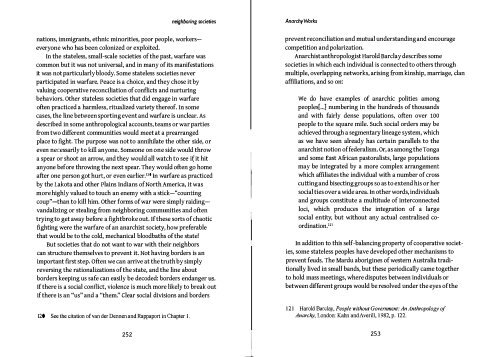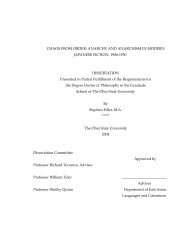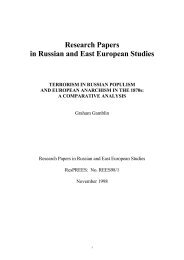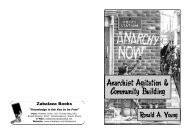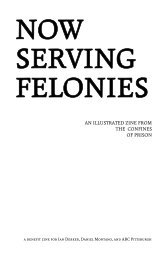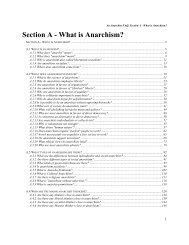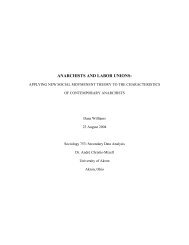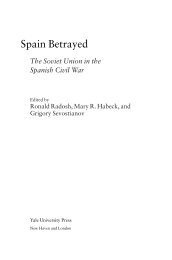Anarchy Works.pdf - Infoshop.org
Anarchy Works.pdf - Infoshop.org
Anarchy Works.pdf - Infoshop.org
You also want an ePaper? Increase the reach of your titles
YUMPU automatically turns print PDFs into web optimized ePapers that Google loves.
neighboring societies<br />
<strong>Anarchy</strong> <strong>Works</strong><br />
nations, immigrants, ethnic minorities, poor people, workerseveryone<br />
who has been colonized or exploited.<br />
In the stateless, small-scale societies of the past, warfare was<br />
common but it was not universal, and in many of its manifestations<br />
it was not particularly bloody. Some stateless societies never<br />
participated in warfare. Peace is a choice, and they chose it by<br />
valuing cooperative reconciliation of conflicts and nurturing<br />
behaviors. Other stateless societies that did engage in warfare<br />
often practiced a harmless, ritualized variety thereof. In some<br />
cases, the line between sporting event and warfare is unclear. As<br />
described in some anthropological accounts, teams or war parties<br />
from two different communities would meet at a prearranged<br />
place to fight. The purpose was not to annihilate the other side, or<br />
even necessarily to kill anyone. Someone on one side would throw<br />
a spear or shoot an arrow, and they would all watch to see if it hit<br />
anyone before throwing the next spear. They would often go home<br />
after one person got hurt, or even earlier.l2° In warfare as practiced<br />
by the Lakota and other plains Indians of North America, it was<br />
more highly valued to touch an enemy with a stick-"counting<br />
coup"-than to kill him. Other forms of war were simply raidingvandalizing<br />
or stealing from neighboring communities and often<br />
trying to get away before a fight broke out. If these sorts of chaotic<br />
fighting were the warfare of an anarchist society, how preferable<br />
that would be to the cold, mechanical bloodbaths of the state!<br />
But societies that do not want to war with their neighbors<br />
can structure themselves to prevent it. Not having borders is an<br />
important first step. Often we can arrive at the truth by simply<br />
reversing the rationalizations of the state, and the line about<br />
borders keeping us safe can easily be decoded: borders endanger us.<br />
If there is a social conflict, violence is much more likely to break out<br />
if there is an "us" and a "them:' Clear social divisions and borders<br />
120 See the citation of van der Dennen and Rappaport in Chapter 1.<br />
prevent reconciliation and mutual understanding and encourage<br />
competition and polarization.<br />
Anarchist anthropologist Harold Barclay describes some<br />
societies in which each individual is connected to others through<br />
multiple, overlapping networks, arising from kinship, marriage, dan<br />
affiliations, and so on:<br />
We do have examples of anarchic polities among<br />
peoples[. ..] numbering in the hundreds of thousands<br />
and with fairly dense populations, often over 100<br />
people to the square mile. Such social orders may be<br />
achieved through a segmentary lineage system, which<br />
as we have seen already has certain parallels to the<br />
anarchist notion of federalism. Or, as among the Tonga<br />
and some East African pastoralists, large populations<br />
may be integrated by a more complex arrangement<br />
which affiliates the individual with a number of cross<br />
cutting and bisecting groups so as to extend his or her<br />
social ties over a wide area. In other words, individuals<br />
and groups constitute a multitude of interconnected<br />
loci, which produces the integration of a large<br />
social entity, but without any actual centralised coordination.12l<br />
In addition to this self-balancing property of cooperative societies,<br />
some stateless peoples have developed other mechanisms to<br />
prevent feuds. The Mardu aborigines of western Australia traditionally<br />
lived in small bands, but these periodically came together<br />
to hold mass meetings, where disputes between individuals or<br />
between different groups would be resolved under the eyes of the<br />
121 Harold Barclay, People without Government: An Anthropology of<br />
<strong>Anarchy</strong>, London: Kahn and Averill, 1982, p. 122.<br />
252<br />
253


